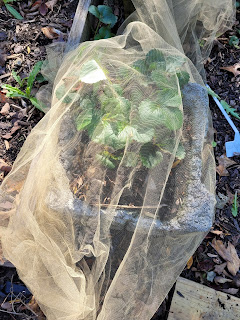Tulle Fabric
Ten Uses in the Garden!

If you've never used Tulle fabric in your garden, you're missing out on a great opportunity!
First, what is Tulle fabric? Tulle is a soft, fine silk, rayon or nylon material commonly used to make wedding veils and dresses.
Advantages of Using Tulle Fabric in the Garden
- Tulle fabric is available by the bolt in a wide range of widths, colours and mesh sizes and can be easily found at any fabric store or ordered through Amazon.
It is as tight as it is light so water and air can easily go through it.
It is as tight as it is light so water and air can easily go through it.
- If you purchase the white or a light-colored Tulle, you can see the plants through the fabric. And because it does not obscure your view of the plants, you can visually inspect the garden without having to remove any covers. Most floating row covers are too densely-woven to see through.
- Tulle is easy to secure to garden beds or containers with clothes pins or clips.
- Tulle can be used year after year.

- It comes in a variety of colors!
Ways to Use Tulle in the Garden
1. Covering Freshly Seeded Areas
The Tulle fabric is so light that you can just drape the fabric right over the planted area without crushing tiny seedlings.
2. Tulle Fabric as a Row Cover
Tulle can be used on young squash plants and the like. It's a great alternative to buying expensive netting.
3. Tulle As Bird Netting
Regular bird netting can catch on plants, can catch on small bird claws and can be very difficult to remove. Rolling up, storing and untangling bird netting can be another problem.
Tulle doesn’t catch nearly as much as the bird netting does, and is easy to remove and is tangle free.
4. Pest Deterrent - Insect Barrier
Tulle can be used to cover your eggplant to protect the plant from flea beetles. It's also effective in keeping out Japanese beetles.
Brassicas are always a challenge to protect against flea beetles, aphids, and cabbage worms. No problem. Tulle fabric's netting holes are small enough to prevent cabbage butterflies from laying eggs on the leaves.
And since cabbage crops are cool-season crops, the Tulle netting allows for more air circulation around the plants than a floating row cover does.
Got squirrels? I do, and this is one of my favorite usds. Use Tulle fabric around bird feeder poles to deter squirrels from climbing up to the feeder. It only takes one time for the squirrels to get their nails caught in the fabric to keep them away from the bird food.
A cooling shade cover can make a huge difference for plants like snap bean plants that wilt badly in the mid-day summer heat. I use a double layer of Tulle for use as a shade cloth. Use a darker color for even more shade.
When hardening off seedlings, get an extra layer of shade by using several layers of Tulle at first and then gradually reducing the number of layers as the plants get acclimated to sunshine. It's a good way to harden off your plants if you can't be home to move seedlings in and out of direct sun.
9. Tulle to Completely Tie up Plants to Stakes
Cut the Tulle pieces into strips and use the strips to tie up top-heavy plants like tomatoes and peppers. Tulle will stretch to allow the plants to grow and won't hurt the plant.

10. Tulle To Completely Cover Smaller Pots
Larger Tulle fabric pieces can be used to drape over entire small or medium-sized containers.
If you're using the Tulle to cover fruiting plants, just remember to remove it once your plants begin to produce blooms so pollination can occur.
11. Tulle for Making Compost or Comfrey Tea
Wrap your compost or comfrey leaves inside a piece of Tulle and submerge them in a bucket of water for making compost or comfrey tea. Then simply pull out the Tulle when the tea is finished and ready to use to fertilize your plants.
13. Tulle for Seed Saving
If you're a seed saver, smaller pieces of Tulle fabric can be used to bag the fruits you want to save for seed later. Tulle fabric is what most blossom bags are made of.
The only down side I've noticed in using the Tulle fabric in the garden is the fact that it can tear easily. But luckily there are many uses for smaller pieces of Tulle.
I have found the washing machine to be quite harsh on Tulle fabric. One way to prevent it from catching on zippers and other clothing hardware is to tie the Tulle inside a pillow case when washing.
Washing Tulle by hand in cool water with mild soap works well. I have found that the Tulle fabric will last longer if the fabric is left to air dry instead of suing a dryer.
This post may contain some Amazon Associate links meaning that I will get a small compensation at no expense to you if you purchase something from this blog.









Comments
Post a Comment